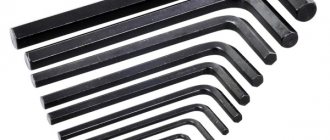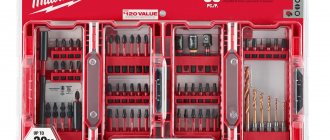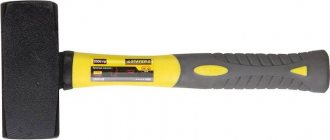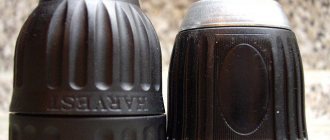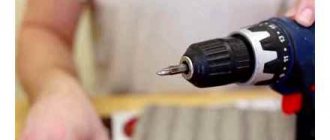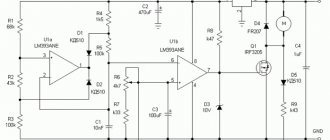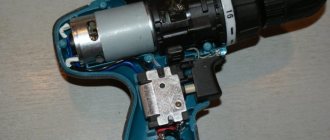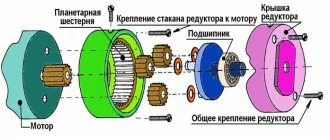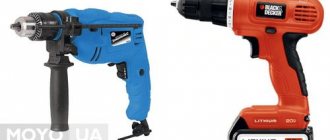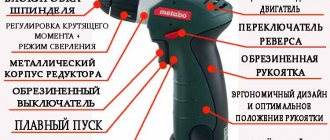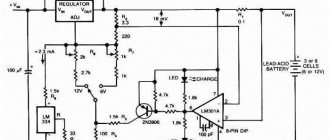Perhaps you need:
Screwdriver attachment PH 2x25mm
More details
Screwdriver attachment PZ 2x50mm
More details
Screwdriver attachment PH 2x50mm
More details
The use of special attachments (bits) in assembly technology was at one time due to the rapid failure of the tips of conventional screwdrivers when used professionally. In this regard, replaceable bits, invented in the first half of the 20th century, turned out to be more profitable and convenient.
When tightening several hundred screws with a screwdriver with a tip, they began to change not the screwdriver, but only its attachment, which was much cheaper. In addition, when working with several types of fasteners at once, many different tools were not required. Instead, the only screwdriver required changing the bit, which only took a few seconds.
However, the main motivation for the use of bits was the invention of centered fastener heads. The most common of them are cruciform ones - PH and PZ. Upon careful study of their designs, it can be established that the tip of the nozzle, pressed into the center of the screw head, does not experience significant lateral forces that throw it beyond the head.
Other types of fastening heads used today are also built according to the self-centering system. They allow you to twist elements not only at low speeds, but also at significant speeds with a large axial load.
The only exceptions are S-type straight blade bits. These were historically intended for the very first hand-tightened screws. There is no centering of the bit in straight splines, so when the rotation speed increases or the axial pressure decreases, the bit slips out of the fastening head.
This can result in damage to the front surface of the element being fastened. Therefore, in the mechanized assembly of critical products, connections with straight spline elements are not used.
Its use is limited to less critical fasteners with low tightening speeds. When assembling products with mechanical tools, only those types of fasteners are used that ensure a reliable fit of the nozzle to the fastening element.
Bit classification
Fastening bits can be classified according to several criteria:
- type of fastening system;
- head size;
- bit shaft length;
- rod material;
- metal coating;
- design (single, double);
- possibility of bending (regular and torsion).
The most important thing is to divide the bits into types of fastening systems. There are many of them, the most common ones will be discussed in a few paragraphs.
Almost every type of system has several standard sizes, differing in the size of the tool head and the corresponding fastening slot. They are designated by numbers. The smallest ones start from 0 or 1. The recommendations for the type indicate the diameters of the threads of the fasteners for which the bit is intended under a specific number. Thus, the PH2 bit can be used with fasteners with a threaded diameter from 3.1 to 5.0 mm, PH1 is used for self-tapping screws with a diameter of 2.1–3.0, etc.
For ease of use, bits are available with different shaft lengths - from 25 mm to 150 mm. The tip of a long bit reaches the slots in places where a larger bit holder cannot reach.
Cross bits (Pozidriv)
Later, specifically for the production of furniture and construction work, Philips Screw Company developed a new type of cross-head slot. It was named Pozidriv. This type of spline was patented in 1966. The bits for this slot are marked with the letters PZ. They are designed to work with wood or other similar materials that have a heterogeneous structure. At the same time, PH type bits are more suitable for working with metal.
A distinctive feature of the PZ system, in comparison with the PH, is that the edges of the working surfaces are located parallel to each other and are made of the same thickness along their entire length, and the slot itself is much deeper. This design feature prevents the bit from being pushed out when tightening the fastener. Thanks to this, a tighter contact is formed between the screw head and the bit, which reduces wear on the elements. In this case, there is no need to apply large axial forces when the tip is pressed onto the slot.
It must be remembered that when choosing a bit for tightening fasteners for a PZ slot, you must use a PZ type bit. If you use a PH type nozzle to screw products into a PZ slot, the surfaces will not be in close contact with each other, which will shorten the life of the nozzle.
Source: srbu.ru
Materials and coating
The alloy material from which the bat is made is the key to its durability or, conversely, the softness of the design, in which, if the specified forces are exceeded, it is not the fastening element that breaks, but the bat. In some critical connections this strength ratio is required.
However, in the vast majority of applications, the user is interested in the maximum possible number of tightenings of the fastener with one bit. To obtain strong bits that do not break due to the fragility of the alloy, and do not deform at the most loaded touch points, various alloys and steels are used. These include:
- high-speed carbon steels from R7 to R12;
- tool steel S2;
- chrome vanadium alloys;
- tungsten-molybdenum alloy;
- chromium-molybdenum alloy and others.
Special coatings play an important role in ensuring the strength properties of bits. Thus, a layer of chrome vanadium alloy protects the tool from corrosion, and sputtering a layer of titanium nitride significantly increases its hardness and wear resistance. Diamond coating (tungsten-diamond-carbon), tungsten-nickel and others have similar properties.
The titanium nitride layer on the bit is easily recognizable by its golden color, and the diamond layer by the characteristic shine of the tip. The brand of metal or alloy of a bat is more difficult to find out; the manufacturer usually does not provide or even hides this information for commercial interests. Only in some cases can a steel grade (S2, for example) be applied to one of the faces.
Choosing high-quality accessories for a screwdriver
The screwdriver is widely used by both home craftsmen and professionals at construction sites and in other fields of activity. It is used to tighten screws, self-tapping screws, screws, bolts, and also drill holes in various materials. For each type of fastener, you need a suitable shaped screwdriver bit. Working attachments for the power tool you are using can be purchased in sets or individually: it all depends on the variety of types of fasteners with which you will be working.
If you only need to occasionally connect parts, then it is enough to purchase a few of the most common bits. For professionals, it is more convenient to buy attachments in one set for different fasteners. Classification of products by size and type, as well as recommendations by manufacturer, will help you navigate the extensive assortment without any problems.
Types of bits
The screwdriver accessories consist of the following accessories:
magnetic or regular bits and holders for them (extensions); drills
The bit is a rod with six edges, on one side of which there is a working profile, and the other end is intended for fixation in a power tool chuck or in a holder. This special nozzle must be sized to match the type of fastener (self-tapping screw, screw, screw, bolt, etc.).
Drills for screwdrivers represent a separate category of equipment. They are taken from ordinary (unstressed) drills. In this case, the maximum diameter of the drills is limited by the largest cross-section of the tail section, which the tool chuck is capable of clamping.
Existing types of bits differ in the shape of their working part. Based on this feature, the following groups of this equipment are distinguished:
We recommend: DIY rollers for decorative plaster
main (standard), which includes straight, cross-shaped, hexagonal tips, as well as in the shape of an asterisk and for bolts; special, for example, bits equipped with spring clamps, limit stops (designed for screwing drywall sheets), triangular; combined, in which the nozzles are equipped with two working parts of different shapes or sizes.
Bit extenders are divided into two types:
magnetic, holding the inserted nozzle due to the force of a magnetic field; spring ones, in which the tail part is fixed rigidly.
Standard equipment
Standard attachments are included in any set; they are used most often in work. The very first of the variety of equipment to appear were straight (slotted) bits. This classic option is designed to work with screws or screws that have a straight cut. Spline equipment is marked with the letter S (from the word slot), next to which a number is placed. The number indicates the slot width, which ranges from 3-9 mm. The thickness of the tip is not specified, but its standard value is in the range from 0.5 to 1.6 mm. The marking located on the shank also contains an indication of the material from which the equipment is made.
There are spline bits with a gold titanium nitride coating. Then the marking contains the TIN designation. In this case, the width of tips with titanium coating can be from 4.5 to 6.%!m(MISSING)m, and the thickness – 0.6-1.2 mm.
There are elongated spline-type nozzles. They are 5-10 cm long.
Cross-shaped (cross) bits are divided into two groups:
Ph (from Philips) - a universal type with a length of 2.5 to 15 cm (there are also 30 cm flexible holders), with a working part of four diagonal ribs;
PZ (Pozidrive) is a tool of different lengths, equipped, in addition to 4 main ribs, with four additional ones.
Philips equipment has four standard sizes: from Ph-0 to Ph-3. The number corresponds to the outer diameter of the fastener.
The most popular of all is the Ph-2 size, which is widely used in household work.
Pozidrive attachments come in the following sizes:
PZ0 are used to work with screws up to 2.5 mm in diameter; PZ1 - they are used to tighten fasteners from 2.5 to 3.5 mm; PZ2 are designed for 3.5-4 mm screws; PZ3 and PZ4 allow you to work with large screws and anchor bolts.
Cross-shaped equipment is the most common compared to other varieties. It may also have a titanium coating.
The hexagonal bits are marked with the letter H (from the phrase Hex socket). Such attachments can be:
classic type, size 1.5-10 mm;
hexagonal in shape, but with an internal hole (their dimensions range from 1.5-6 mm);
elongated, with working part sizes from 3 to 8 mm and a length of 5-10 cm.
Hexagons are widely used in furniture production, during installation/dismantling of water supply or heating systems.
Star bits are marked with the letter T followed by a number. They are used in the assembly/disassembly of household appliances, as well as cars. They come in the following varieties:
Torx (classic), sizes T8-T40;
Torx Plus (their beams are less sharp), sizes from T10 to T40;
with titanium coating (TIN), sizes T10-T40;
with internal hole (standard size T10-T40);
elongated: sizes from T10 to T40, length 5-10 cm.
Nozzles designed for tightening or unscrewing fasteners with a hexagonal head (bolts, nuts) have a size of 6-13 mm. The most common of these are eight-millimeter bits.
There are magnetized and non-magnetic modifications, with the price of the former being approximately 1.5 times higher.
Special attachments
Special equipment includes the following types of bits:
three-blade (Tri wing), sizes TW0-TW5;
four-blade (Torq-set, designated Gr), size 4-10 mm;
classic and elongated tetrahedral (Robertson square, with a square slot), designated by the letter R;
elongated and classic “fork” shaped (designated Gr).
There are also tips with other special shapes, but they are used extremely rarely.
Classification of bits by material and coating
Their strength characteristics and wear resistance depend on the properties of the material from which the hardware is made, as well as on the coating. The following alloys are considered the best for the manufacture of screwdriver attachments:
chromium vanadium (symbolized Cr-V);
Cross Phillips Bits (Cr-V)
chromium-molybdenum (Cr-Mb); tungsten-molybdenum.
The most common is an alloy of chromium and vanadium.
Hardware is also made from other metals, for example, from high-speed steel (from R7 to R12). But such cheaper alloys are inferior in their performance indicators (strength, wear resistance) to the considered options.
The screwdriver attachment for self-tapping screws, bolts and other types of fasteners can be coated with the following materials:
nickel; titanium; tungsten carbide; diamond coating.
BISON "EXPERT" attachments with diamond coating
The applied coating increases the resistance of working tips to corrosive processes, increases their wear resistance, as well as strength characteristics. Titanium coating emphasizes the quality of the product. It has a yellow tint.
Recommendations for choosing bits for work
The market for attachments designed to equip a screwdriver is filled with products of varying quality and from different companies. For this reason, the question is relevant: which manufacturers’ products are best purchased as a set, and which ones separately? The correct choice in this case determines not only the time of use of the purchased bits, but also affects the service life of the power tool used, and also affects the quality of the work performed.
Tips for purchasing piece goods
For individual purchase, experts recommend Whirl Power (WP) brand products. It can be easily distinguished from analogues by the presence of a branded green sticker. The products of this company have earned great popularity and authority due to their good magnetic properties, as well as significant hardness, which increases service life due to slow wear. The attachments can be easily inserted into the chuck without falling out when the power tool is tilted down. Magnetic bits hold metal fasteners well - this allows you to conveniently perform work in hard-to-reach places.
We recommend: Do-it-yourself vices - making a bench vice at home
For practical use, the following bit sizes from Whirl Power are popular:
25 mm; 50 mm; 75 mm; 90 mm.
Long nozzles measuring 150 mm are also widely used.
To work with most types of fasteners, standard WP2 models are used. If you need to perform operations with decorative modifications of self-tapping screws, then use tips for a WP1 screwdriver. The working parts are equipped with notches that increase their resistance to wear.
Almost as popular as Whirl Power among buyers are products from Bosch, which traditionally supplies the market with high-quality power tools. The quality of screwdriver attachments from this brand is also emphasized by their high price. At the same time, titanium-coated products, marked with a yellow color, are especially popular. The main materials for their manufacture are chrome vanadium, tungsten molybdenum or chrome molybdenum alloys. In addition to titanium, tungsten carbide, diamond or nickel are also used as a protective coating for the working parts.
The presence of titanium coating significantly increases the cost of products. Because of this, hardware from Bosch is priced 2 or more times higher than analogues from Whirl Power. In such cases, the financial issue comes to the fore when choosing nozzles.
Cheaper competitors to Bosch are hardware from DeWALT. Their distinctive feature is a high degree of impact resistance. They can be used regularly for a long time. For everyday use, hardware from Magna is also suitable. If handled carefully, they can last a long time.
Torsion bit Ph2, Extra Grip L 25 mm DeWALT DT72381
If you need to buy equipment for a certain type of fastener, it is recommended to take a sample with you. This will allow you to choose the best tip option by trying it on the cap before purchasing.
Popular attachment kits
You can select bits for a screwdriver in one set. The stores offer many ready-made selections of hardware, packaged in boxes that are convenient for storage and use. In such cases, each element is placed in a separate place, while its size is indicated next to it.
Professional sets of attachments from Hitachi and Kraftool stand out among competitors for their excellent quality. They contain hardware of all standard sizes used in various fields of practice.
The kits even include heads for installing roofing screws.
If you buy a set of high-quality hardware, then such a purchase will cost less than purchasing a similar product individually. Purchasing a kit, allowing you to save money, is very convenient when carrying out professional activities.
Despite the wide variety of shapes of working tips for screwdrivers and differences in the material from which they are made, in any case you should choose high-quality equipment. Purchasing products from well-known brands that have proven themselves over many years is the right decision for professional activities and large regular volumes of work performed. Such products will last a very long time, contributing to the efficient performance of work tasks. Low-quality, cheap kits can be purchased for household use. But it should be borne in mind that they wear out quickly, causing a lot of inconvenience during the work process.
Source: Tehnika.expert
4
Star inserts
Star-shaped bits are marked with the letters T or TX (Torx). They are actively used in mechanical engineering and in the production of household appliances. Next to the letter on the products there is a number indicating the size of the nozzle - the distance between the rays of the star. The classic star-shaped spline is most common in the USA and Western European countries, due to its high reliability.
Star-shaped inserts in screwdrivers provide excellent adhesion of the bit to the surface of fasteners, due to which it is not necessary to apply significant effort for tightening. The star-shaped shape minimizes the likelihood of the screwdriver slipping, because the load is distributed across 6 edges at once, which also reduces wear on the attachment. The most common asterisk bit sizes are models labeled TX8-TX40.
Star bits are most often used in mechanical engineering and in the production of household appliances
There are nozzles on the market called Torx Plus, in which the sprocket has sharp rays that are shorter in length than standard ones. Such inserts require caution when working, although they are made of high quality steel and have a long service life. Torx Plus grades are available on the market in standard star sizes from T10 to T40.
Star-shaped inserts are also coated with titanium nitride, elongated and with a hole inside. TIN coating for products of the TX10-TX40 brands provides them with greater reliability and long service life. Thanks to the hole inside the sprocket, the quality of fastening is improved, but inserts of this type are used primarily in production. Extended bits make screw handling easier and come in lengths up to 10cm.
Design options
By design, the bit can be single (a tip on one side, a hex shank on the other) or double (two tips at the ends). The latter type has a double service life (both tips are the same) or ease of use (the tips differ in size or type). The only disadvantage of this type of bit is the impossibility of installing it in a hand screwdriver.
Bits can be produced in regular and torsion versions. In the latter design, the tip itself and the shank are connected by a durable spring insert. It works by twisting, transmits torque and allows you to bend the bit, which increases the ability to access inconvenient places. The spring also absorbs part of the impact energy, protecting the bit from breaking the splines.
Torsion bits are used with impact screwdrivers, in which the impact force is applied tangentially to the screwing circle. Bits of this type are more expensive than regular ones, last longer, and allow you to screw long fasteners into dense materials that regular bits cannot handle.
For ease of use, bits are produced in different lengths. Each following standard size (25 mm) is 20-30 mm longer than the previous one - and so on up to 150 mm.
The most important characteristic of a bit is its service life. It is usually expressed in the number of fasteners screwed in before the tool fails. Deformations of the tip are manifested in the gradual “licking” of the ribs as the bit slips out of the slot. In this regard, the most resistant bits are those that are not subject to forces that throw them out of the slot.
The most commonly used systems include H, Torx and their modifications. In terms of strong contact between the bit and the fastener, there are many other systems, including anti-vandal ones, but their distribution is limited for a number of technical reasons.
Types of screwdriver bits: marking, classification
Replaceable attachments that screw in and unscrew fasteners partially duplicate the tools that you have in the house, while others are rarely used in everyday life. Therefore, experts recommend purchasing products separately, and not buying an expensive set with a specific (manufacturer) screwdriver set. In order not to make a mistake with your choice, you need to have information about the classification of elements. But even in this case, there may be problems with fasteners slipping from the head, rapid discharge of the power tool’s battery, and other troubles. A corded screwdriver is a very useful tool in the household, which allows you to unscrew and screw in bolts, screws and similar parts without serious physical effort and in a short time. The main element of a screwdriver is a bit - a hexagon, which is screwed into the tool with one side and the working side engages the necessary fasteners.
Marking bits for a screwdriver
So, a bat is a special nozzle with a hexagonal shank.
com, allowing you to “engage” with a special screw connection. When purchasing products, it is recommended to have a sample of the fastener with you to check whether the bits match it. Construction stores offer a wide range of bits for various fasteners, and it’s easy to get confused in all this variety. Attention should also be paid to the reliability of fixation in the tool. The quality of work will directly depend on this, and the service life of the product and tool will increase.
The following brands are distinguished:
PH standard. The products have a cross slot with a vertex angle of 55°. All 4 splines have an extension towards the shank. The PH marking includes numerical indices indicating the dimensions of the slot. Products with the smallest slot size are given the name PH 0, and bits with the largest diameter - PH 3. The designation PH 2 is very common, since bits with it are used for fastening self-tapping screws. PH 2 is a universal standard that suits almost any self-tapping screw. PZ standard. Improved modernized previous standard. Essentially, it is a cross slot with equal thickness on all ribs. Standard SL. Straight slot with different widths. In the marking, the width in millimeters is indicated after the name of the standard. Torx, 6-point star. The slot resembles a hexagonal star, the only difference being the diameter of the star. The diameter of the slot is usually indicated in millimeters and is marked as follows: Torx 7, where 7 is the diameter in mm. Products are mainly used where a lot of force is required to tighten the fasteners.
Bit classification
The products described are three -sided and hexagonal, flat, for bolts, for drywall.
Screws and screws are screwed flat. Dimensions - 3−7 mm. Hexagon screws are used to tighten screws with an internal 6-sided hole. Mainly used in furniture production. Bits for bolts are used in construction, and they are used to fasten tiles or corrugated sheets. Dimensions - 6−13 mm. Products for drywall have a built-in limiter that prevents the screw from going far into the material. Trihedrons resemble the cross version, but have only three sides, as the name suggests.
Basic Standards
Spline bits are a classic choice for screw and screw heads. The slot allows you to use a flat screwdriver. The width of the tip is measured in millimeters and is indicated on the tail. In addition to width, spline bits differ in the depth of their element. Cross bars have four diagonal ribs that provide excellent adhesion to fasteners. Dimensions - 25−150 mm. Hex sockets are used with socket head screws, typically in furniture assembly/disassembly where hex head fasteners are more common. Bits for nuts and bolts. With their help, large hardware with an external hexagon of high load-bearing capacity is screwed in. Diameter - 6−13 mm. Star bits. Used for fastening in automotive equipment.
Matching bit to tool
It is very important what material the product is made of and whether it has a coating, and if there is a coating, how long it can withstand exposure to the external environment.
The most common products are those marked Cr-v, made from alloys of vanadium and chromium. Products with nickel plating are also popular - strong and durable, especially good if tungsten is applied over nickel - no rust for many years.
Basic selection rules
Make your purchase from a reliable, trusted store. Give preference to inexpensive brands if you require high-quality products with a long service life. Cheap bits sold in unverified retail outlets should raise suspicions. Although you can take this product for one-time use. Evaluate the material and its properties. Chromium and molybdenum alloys are considered the most reliable. Refrain from purchasing steel products, as they have low durability and you will not be able to work with them efficiently and quickly. Please note that there is a protective coating. The product will be of excellent quality if it has a titanium coating.
We recommend: Types of construction guns for sealant – which one to choose and how to use?
Selection according to generally accepted characteristics
According to the general characteristics , bits are basic, combined and special:
The main products consist of a working element - a cross, and must provide high-quality fixation with the heads of the fastening elements. Combined - products with a double working part. Parts may vary in size and type of fasteners. During the work process, the unnecessary part of the bit is unscrewed, the bit is secured in the screwdriver chuck and the remaining working part is used. Specialized products are highly specialized products that are almost never widely used.
Whatever the brand and whatever type of bat, the main criteria for its selection are reliability and quality. Its task is to achieve maximum adhesion to the fastening element. The product must be wear-resistant, have an acceptable price and the required characteristics.
Source: tokar.guru
This is interesting: Do-it-yourself water heated floor in a private house (video)
3
Hex bits
The hexagonal shape of the notch appeared at the beginning of the 20th century and was called Hex socket, which remains today; such inserts are marked with the letters HEX. The most important characteristic of these nozzles is the distance between the sides of the hex tip. There is a type of slot protected from unauthorized disassembly; it is distinguished by a special pin in the center of the slot and is marked as Hex-Pin.
Hex bits appeared at the beginning of the twentieth century
Classic hex bits for self-tapping screws are products ranging in size from 1.5 to 10 mm. They began to be actively used in the USA, and then throughout the world. The attachment may have a small hole inside, thanks to which the fasteners do not slip off while using a screwdriver. Bits with holes are up to 6 mm in size.
On the market you can find extended hexagonal sockets of the Hex- brand. They are used quite rarely, although they are easy to use and durable, as they are made from high-quality steel. The dimensions of the extended nozzles range from 3 to 8 mm, and the length is up to 10 cm.
Main types of bits used
The number of types of bits, including those that have fallen out of use due to low technical suitability, amounts to several dozen. Today, the following types of screwdriver attachments are most widely used in fastening technology:
- PH (Phillips) - cross-shaped;
- PZ (Pozidriv) - cruciform;
- Hex (denoted by the letter H) - hexagonal;
- Torx (denoted by the letters T or TX) - in the form of a six-pointed star.
PH nozzles
The PH Phillips, introduced after 1937, was the first self-centering tool for driving screw-threaded fasteners. The qualitative difference from the flat tip was that the PH cross did not slip out of the slot even when the tool was rotated quickly. True, this required some axial force (pressing the bit against the fastener), but ease of use compared to flat splines increased sharply.
Clamping was also required in screws with a flat slot, but when tightening with a PH bit, it was not necessary to apply attention and effort to limit the possibility of the tip slipping out of the slot. The tightening speed (productivity) has increased dramatically even when working with a manual screwdriver. The use of a ratchet mechanism, and then pneumatic and electric screwdrivers, generally reduced the complexity of assembly operations several times, which provided significant cost savings in any type of production.
The PH bit has four blades that taper in thickness towards the end of the bit. They capture the mating parts of the fastener and tighten it. The system is named after the engineer who introduced it into fastening technology (Phillips).
PH bits are available in five sizes - PH 0, 1, 2, 3 and 4. Rod length - from 25 (main) to 150 mm.
PZ nozzles
About 30 years later (in 1966), the PZ (Pozidriv) fastening system was invented. It was developed by Philips Screw Company. The shape of the PZ tip is cross-shaped, like that of the PH, but both types have such serious differences that they do not allow the bit of one system to properly tighten the fasteners of the other. The sharpening angle of the end of the bit is different - the PZ has it sharper (50 º versus 55 º). The PZ blades do not taper like those of the PH, but remain equal in thickness throughout their entire length. It is this design feature that has reduced the force of pushing the tip out of the slot under high loads (high twisting speeds or significant rotational resistance). Changing the design of the bit improved its contact with the fastener head, which increased the service life of the tool.
The PZ bit differs from the PH bit in appearance - grooves on both sides of each blade, forming pointed elements that are absent on the PH bit. In turn, to distinguish it from PH, manufacturers apply characteristic notches on PZ fasteners, shifted 45º away from the power ones. This allows the user to quickly navigate when choosing a tool.
PZ bits are available in three standard sizes PZ 1, 2 and 3. The length of the rod is from 25 to 150 mm.
The greatest popularity of the PH and PZ systems is explained by the good capabilities of automatic tool centering in in-line assembly operations and the relative low cost of tools and fasteners. In other systems, these benefits have weaker economic incentives, so they are not widely adopted.
Hex attachments
The shape of the tip, designated in the marking by the letter H, is a hexagonal prism. The system was invented back in 1910 and enjoys continued success today. Thus, confirmed screws used in the furniture industry are tightened with H 4 mm bits. This tool is capable of transmitting significant torque. Thanks to the tight connection with the fastener slot, it has a long service life. There is no force to push the bit out of the slot. H nozzles are available in sizes from 1.5 mm to 10 mm.
Torx bits
Torx bits have been used in technology since 1967. They were first mastered by the American company Textron. The sting is a prism with a base in the form of a six-rayed star. The system is characterized by tight contact between the tool and the fastener and the ability to transmit high torque. Widely distributed in America and Europe, in terms of popularity the volume of use is close to the PH and PZ systems. A modernization of the Torx system is an “asterisk” of the same shape, complemented by a hole in the axial center. The fastener for it has a corresponding cylindrical protrusion. In addition to even tighter contact between the bit and the screw head, this design also has an anti-vandal property, preventing unauthorized unscrewing of the connection.
Other types of attachments
In addition to the popular attachment systems described, there are also lesser-known and less commonly used types of screwdriver bits. The following bits fall into their classification:
- for a straight slot type S (slotted - splined), invented in the 26th century;
- Hex type with a hole in the center;
- Robertson type square prism;
- fork type SP (“fork”, “snake eye”);
- three-bladed Tri-Wing type;
- four-bladed type Torg Set;
- and others.
Companies are developing their unique bit-fastening systems both to prevent non-experts from accessing instrument compartments and to protect against vandals looting the contents.
Cross bits (Phillips)
The cross-shaped bat first appeared in the first half of the 20th century. This was facilitated by the fact that when using fasteners and slotted screwdrivers in the automotive industry, when assembling parts, they often came out of the heads of screws and screws, which led to damage to the varnished coating of the vehicle. Also, the threads of fasteners often broke due to the fact that torque limiters, which later began to be used in mechanical screwdrivers and screwdrivers, had not yet been invented.
All of these reasons contributed to the invention of the Phillips screw in 1933 by John Thompson. Three years later, the patent for this invention was acquired by Henry Phillips. This engineer refined the production technology and in 1937 invited Eugene Clark, who was a major manufacturer of metal products, to hold a competition to see who could tighten the screws the fastest. Naturally, Henry Phillips won the competition. After this, a new type of attachment attracted the attention of US automakers, but World War II soon began. Therefore, the cross-head slot appeared in Europe, along with the supply of American military equipment.
Recommendations for choosing bits
A good bat can perform many more fastener tightening operations than its simplified counterpart. To choose the desired tool, you need to contact a retailer whose employees you trust and get the necessary recommendations. If this is not possible, choose bits from well-known manufacturers - Bosch, Makita, DeWALT, Milwaukee.
Pay attention to the presence of a hardening titanium nitride coating, and also, if possible, to the material of the product. The best way to choose is to try out one or two pieces of equipment in your own business. This way you will not only determine the quality of the product yourself, but will also be able to give recommendations to your friends. Perhaps you will settle on an inexpensive option that has clear economic or technical advantages over the originals of famous companies.
High-quality screwdriver attachments can always be purchased at the Stroybat online store for professional fasteners.
How to choose bits for a screwdriver: a cheat sheet for the master
Modern power tools greatly facilitate the repair, assembly and dismantling of fasteners. However, it can also disappoint when an employee does not have sufficient knowledge and makes irreparable mistakes.
A home craftsman's drill and screwdriver can fail at the most inopportune moment due to a poorly working attachment.
Do you want to be safe and confident when working with them? Learn how to choose screwdriver bits and stop worrying about the end result.
Types of bits and their purpose
Screwdriver bits differ in the shape of the working part, on which their purpose depends.
All types of products can be purchased as a set, which is much cheaper than buying them separately.
But before that you need to make sure the quality of the bits.
To make the right choice you need to know the types, sizes, bits, their main differences and the material from which they are made.
Bits for nuts and bolts
Such bits have a non-standard shape.
Their peculiarity is that they do not have a convex working part, but with a hole, and there are a large number of standard sizes.
It must be remembered that to tighten nuts and bolts with a large head diameter, you need to use a high-power screwdriver.
With anti-vandal slot
Craftsmen call a bat with a vandal-proof slot a “snake eye” because... it has a head designed for a fork wrench.
Professional bits
Professional options are characterized by increased reliability, durability and service life.
Such products are capable of screwing in a larger number of screws.
In most cases, they are designed to screw in about 400 screws; after this period, the functionality of the bit should not be impaired.
They have a protective coating and are made of high quality metal.
The set of professional attachments also includes a torsion bit.
It is designed for an impact driver.
You can distinguish a torsion bit from a simple one by its appearance.
It has a narrow part between the slot and the tail.
Its peculiarity is that in its design it has a special flexible insert in the form of a spring, which works to twist.
Therefore, they are popular when working with particularly hard materials when using self-drilling fasteners.
The torsion attachment allows you to sink the self-tapping screw directly with the head into the metal.
Drywall bits
A drywall bit with a limiter is used when working only with plasterboard.
This is due to the fact that when fastening sheets, you cannot press hard on the self-tapping screw, and as soon as the limiter reaches the surface of the material, you must stop working.
If this is not done, the slots from the screw head will be cut off.
This can cause the drywall bit to wear out and cause metal filings to clog the notches.
Fork bits
It is a subtype of anti-vandal slot.
Only high-quality steel is used for manufacturing, which allows it to be durable and serve for a long time.
Outwardly, it resembles a flat slotted bit, which has a slot in the middle.
It can be of increased length and has increased strength.
tri-wing slotted bits
The tri-wing slotted bit is a three-blade bit with the blades positioned at an angle (unlike the ribs in a Phillips bit).
Used in the assembly of household appliances and electronics.
Spring and magnetic
Bits with a spring lock or magnetic tip are designed for work on the ceiling or other hard-to-reach places.
The latches are designed to hold the bits in the adapter.
The magnetic tip allows you to securely fix the bit in the notches of the screw.
We advise you to study - User ratings of ovens for electric and gas models
It is also able to prevent the screwdriver attachment from slipping during operation and allows you to tighten the screw deeper than a simple attachment.
The spring attachment is a special one.
It allows you to work with fasteners that are located at different angles and in hard-to-reach places.
Most often it is a slot and a base, which are connected by a flexible spring for fastening: the slot of such an attachment must be secured manually, inserted into the notches on the screws, and the spring can be bent at any angle, even more than 90°.
